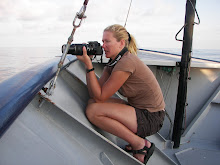 Well, my research cruise in the eastern tropical Pacific (ETP) has ended. The cruise was an incredible experience, both personally and professionally, and will not be something I soon forget. In a month's time, I will be shipping out to Antarctica for a 6-week research cruise. In the meantime, I will begin processing my samples from my grazing experiments conducted in the ETP. It's good to be back on solid ground (for now)! Happy holidays!
Well, my research cruise in the eastern tropical Pacific (ETP) has ended. The cruise was an incredible experience, both personally and professionally, and will not be something I soon forget. In a month's time, I will be shipping out to Antarctica for a 6-week research cruise. In the meantime, I will begin processing my samples from my grazing experiments conducted in the ETP. It's good to be back on solid ground (for now)! Happy holidays!Friday, November 30, 2007
Home from the tropics
 Well, my research cruise in the eastern tropical Pacific (ETP) has ended. The cruise was an incredible experience, both personally and professionally, and will not be something I soon forget. In a month's time, I will be shipping out to Antarctica for a 6-week research cruise. In the meantime, I will begin processing my samples from my grazing experiments conducted in the ETP. It's good to be back on solid ground (for now)! Happy holidays!
Well, my research cruise in the eastern tropical Pacific (ETP) has ended. The cruise was an incredible experience, both personally and professionally, and will not be something I soon forget. In a month's time, I will be shipping out to Antarctica for a 6-week research cruise. In the meantime, I will begin processing my samples from my grazing experiments conducted in the ETP. It's good to be back on solid ground (for now)! Happy holidays!Monday, November 5, 2007
Pteropods

At our first long station, I began a series of experiments on pteropods. These beautiful mollusks are entirely planktonic (spending their entire lives in the water column) and use modified ‘feet’ for wings to propel them through the water. They feed by creating large mucus webs which trap particles and small organisms. Despite their beauty, very little is known of these animals and I began experiments to help determine what they are feeding on and any impact their feeding may have on different size-fractions of the planktonic community. The first set of experiments involved Cavolinia tridentata (pictured above), a pteropod with prominent "wings" and a conspicuous dark spot marking their visceral mass.
Sunday, November 4, 2007
Hello from Station #5 located at 10° 41’41N and 96° 56’6W. The seas calmed down quite a bit for us at our first long station, but are now beginning to pick up again canceling our research plans for tonight. The computers here onboard the ship have been a bit grouchy and so I have focused all my effort on the ETP blog (www.etpcruise.blogspot.com), which details the purpose of this trip and our adventures at sea. Fortunately though it seems that we may have fixed what was wrong, so I can now post some long-awaited pictures onto this site. This research cruise has been an excellent experience for me, exposing me to the technical side of oceanographic research (the methods and equipment involved) and the exciting creatures these tools successfully collect. It has also introduced me to life at sea, which can be very exciting and rewarding (although we all count the days to returning home). On the research vessel, I work for Dr. Karen Wishner from the University of Rhode Island on her MOCNESS team. The MOCNESS (Multiple Opening and Closing Net Environmental Sampling System) consists of a series of 8 nets which can be opened and closed at specific depths in the water column via computer control from onboard the ship. This enables scientists to categorize and enumerate zooplankton populations at specific intervals. In Dr. Wishner’s case, the MOCNESS enables her to identify zooplankton populations at different depths within the oxygen minimum zone, which exists over several hundred meters from beneath the mixed surface layer to approximately 1500 meters in depth. It’s great working with the MOCNESS as I had previously only heard about it through introductory biological oceanography classes.
Subscribe to:
Comments (Atom)


.jpg)




